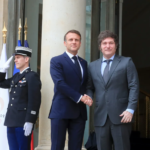Reuse can be useful when it comes to some items, but a broad-stroke target doesn’t work. The point of a circular economy is to take an approach which is tailored to the product, rather than a one-size-fits-all, Tahmid Chowdhury writes.
The amount of what we throw away in Europe is shocking. The sheer volume of rubbish on our continent increased from 66 million tonnes in 2009 to over 78 million tonnes in 2019.
Per person, we generated 177kg of waste in 2020 — that’s equivalent to the weight of two kangaroos. And if we’re not careful, it will increase by a further 20% by 2030.
With plastic pollution in particular piling up, our natural habitats are being damaged and marine animals are becoming collateral damage under the sea. Never mind how much we ship to developing countries which ends up straight in landfill.
So how do we address this growing problem? We need firmer regulation from the EU.
Two birds with one stone
If we are to move towards a sustainable and circular economy, policymakers must not be afraid of ambitious measures. That means encouraging manufacturers to design for durability, to keep products, components and materials circulating in the economy.
However, it is vital they get this right, as the argument is more nuanced than you would think. Especially when it comes to the concept of reuse.
The original proposal stated recycling targets should be put in place, but there would also be binding, mandatory reuse targets, too. The issue: there was little evidence that the reuse targets set within the proposal would actually benefit the environment.
Reuse is simply the idea that we design products to be used again and again by the consumer — think Tupperware, tote bags or reusable coffee cups. This is different to recycling, where waste materials, such as a cardboard box, can be processed and used again by the manufacturer.
The release of the European Commission’s draft Packaging and Packaging Waste Regulation last year was supposed to tackle this specific issue, but businesses were not happy.
The original proposal stated recycling targets should be put in place, but there would also be binding, mandatory reuse targets, too. The issue: there was little evidence that the reuse targets set within the proposal would actually benefit the environment.
Here’s why. Adopting both a reuse and a recycling target is counterintuitive because it makes it difficult for companies to meet two aims at the same time.
Businesses are already taking this seriously
On one hand, you need to recycle your products more but, on the other, you need to design potentially new products that are reusable and find a way to recycle these too.
All the while, the creation of new products uses more energy and resources — which is more emissions-intensive. The process does more harm than good.
The risk with this file was that the EU would lose many potential supporting businesses through ill-defined targets. Still today, I see ads at the Brussels Schuman metro station calling for over 2,000 amendments to the regulation.
Policy is not only there for clarity, it also sets direction and leadership — something the EU needs to improve if it is going to remain competitive on the world stage.
Whilst « industry » can often be branded as an obstacle on the road to climate action, the reality is many players in the packaging sector are forward-thinking. At the Sustainable Packaging Summit this month in Amsterdam, I was inspired by how many companies were openly talking about the importance of reducing carbon emissions and increasing circularity.
For example, Ball, which creates aluminium beverage cans, aims to have a 90% recycling rate by 2030 and will increase the recycled material rates in its aluminium packaging to 85% by the same date. Aluminium can recycling is far more advanced than shifting to a reuse system, the company maintains, which would require dramatically changing its current business model.
Think about it, as consumers, we never drink out of a can more than once. If we want a sustainable and reusable container for our liquids, we use a metal water bottle or coffee cup.
A blanket reuse target for aluminium cans would mean every single one would need to be designed to be reused, it doesn’t make sense.
This goes to show, businesses are already taking this seriously; now we need the appropriate regulation to back them up.
Scattergun approach won’t help
On 24 October, the European Parliament ENVI committee voted through a new position for this regulation. It will go to plenary at the end of November.
The new text takes out the reuse targets, along with some other more ambitious changes.
While taking out reuse may seem like a step backwards, in practice, it will mean a policy that is implementable and better supported across a broad range of stakeholders.
Reuse can be useful when it comes to some items, but a broad-stroke target doesn’t work. The point of a circular economy is to take an approach which is tailored to the product, rather than a one-size-fits-all.
The final draft of the packaging waste regulation will play a critical role in reinforcing the EU’s position as a circular economy.
Policy is not only there for clarity, it also sets direction and leadership — something the EU needs to improve if it is going to remain competitive on the world stage.





































